This summer we raised a pig for meat. Actually, we co-raised three pigs with our neighbors, housing the pigs at their farm, and sharing in the cost and labor. Raised on pasture in the sunshine and fed with 100% non-GMO feed and lots of organic food scraps and whey from Creme Brûlée, they became the most amazingly delicious pork chops and sausages. But the real excitement of raising pigs has been homestead meat curing: Making our own bacon, jowls, salami, lardo, and prosciutto with traditional meat preservation methods.
When we lived in Oregon we raised pigs two years in a row, keeping one pig for ourselves, and selling the others to friends. With our share of the meat, we enjoyed sausage links, roasts, bacon, and even some outstanding salami, which, I’m embarrassed to mention, was cured in a wood cabinet in the bathroom (it was the coldest room in the house!). Now that we have a root cellar, we have an ideal place to go hog wild (sorry) with meat curing.
Meat curing relies on removing or reducing moisture in order to create an environment that is both inhospitable to the bacteria that cause spoil, and beneficial to bacteria that will protect the meat and add flavor. The “good” bacteria are salt-loving, thus the meat curing process begins with salt. Later, smoke may be added to complement the flavor of the meat and to add compounds that enhance preservation.
Since we are still relative newbies, we rely on several very good resources to inform our homestead meat curing. The books Salumi and Charcuterie by Michael Ruhlman and Brian Polcyn are outstanding resources. We’ve also enjoyed The River Cottage Curing & Smoking Handbook. This is a small book – less than 250 pages – that covers a lot of ground, quickly. In it, you can find a bit about the history, techniques, and equipment of curing, as well as over 100 pages of recipes. You’ll find favorites such as dry-cured bacon, prosciutto, salami, and pastrami. There are also many recipes for cured meats that I had never heard of before: ‘Nduja (a spreadable salami), Spalla and speck, and Bresaola. Now my curiosity is piqued!
One of our first cures was lardo, a cured pork fat. In The River Cottage Curing & Smoking Handbook, the author, Steven Lamb, notes that lardo should be “sliced gossamer-thin and can be eaten raw with a small amount of olive oil, or as I particularly recommend, wrapped around freshly steamed asparagus so that it becomes translucent and melting.” Are you salivating, or does this totally repulse you? The lardo will cure for 3-6 months so I have yet to taste it, but here’s how it looks embedded in its salt and spice curing mixture:
The following quote about prosciutto might be the best thing I’ve ever read about curing meat:
“This is the start of a wonderful journey, one that will take you all the way back to the beginning of curing culture and involve over a year of your life….It will be a roller coaster of emotions, triggering the worries you’d expect when meat is unrefrigerated, covered in mold, and from the outside, not appetizing in appearance. Let those doubts come and go. … in time, you will create one of the finest examples of cured meat there is.” – Steven Lamb, The River Cottage Curing & Smoking Handbook
Indeed, the journey to prosciutto is one that has caused some trepidation. First, there is the matter of commitment. Do you truly want to give up such a large piece of meat to this year-long experiment. In the past, we have not (well, there wouldn’t have been enough room in the bathroom anyway). But again, the homestead root cellar has inspired courage and experimentation. Above, you see two pig legs ready to be bathed in salt. And below, to the far left, one of the legs hanging in the root cellar, along with some gorgeous homemade salami.
The salami was made in two flavors: one is a Finocchiona, the other is a Picante; both recipes were adapted from the book Salumi. We purchased casings (although you can prepare them yourself, and here’s a great resource on how to do that), and stuffed the casings with our amazing cast iron sausage stuffer (photos of that process in this post).
And of course, what homestead meat curing party would be complete without the addition of bacon.
The bacon was salted and seasoned, and now hangs in the root cellar, ready to be smoked with our grill’s new smoker attachment. I’m asking Brian to please hold off on that process until I’m done with Whole30. I really don’t think my self-control could hold out against the sweet and salty magnificence that is homegrown-homemade bacon.
Until our homegrown meat cures to perfection, we have enjoyed a number of roasts, chops, and homemade sausage (chorizo is my favorite), but I can’t wait for the day when we cut into one of these cured meats.

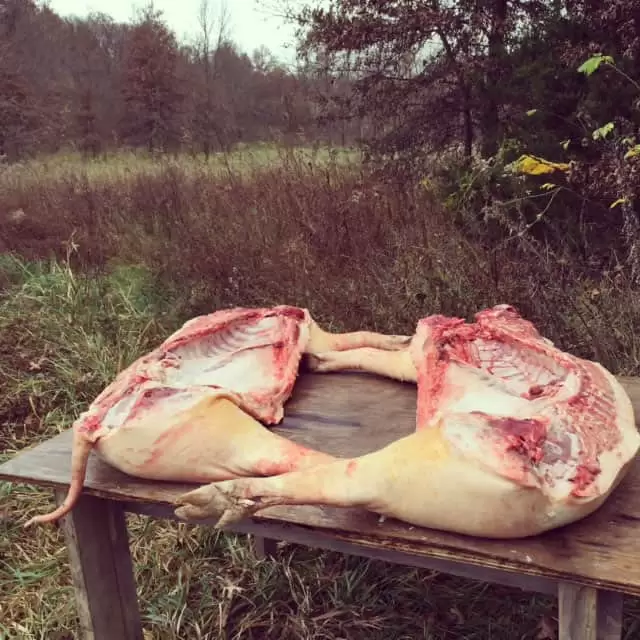

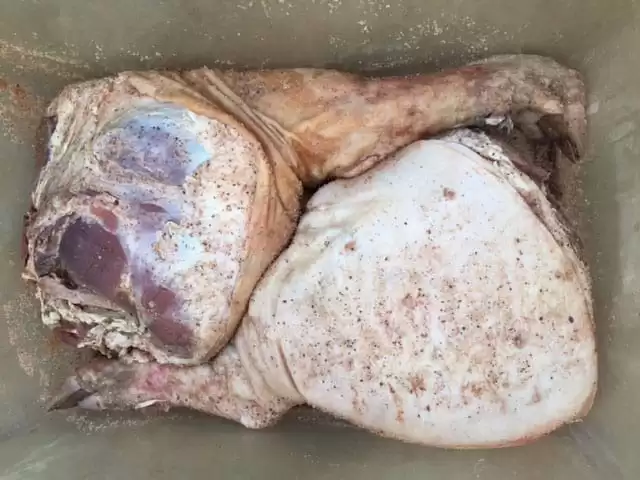


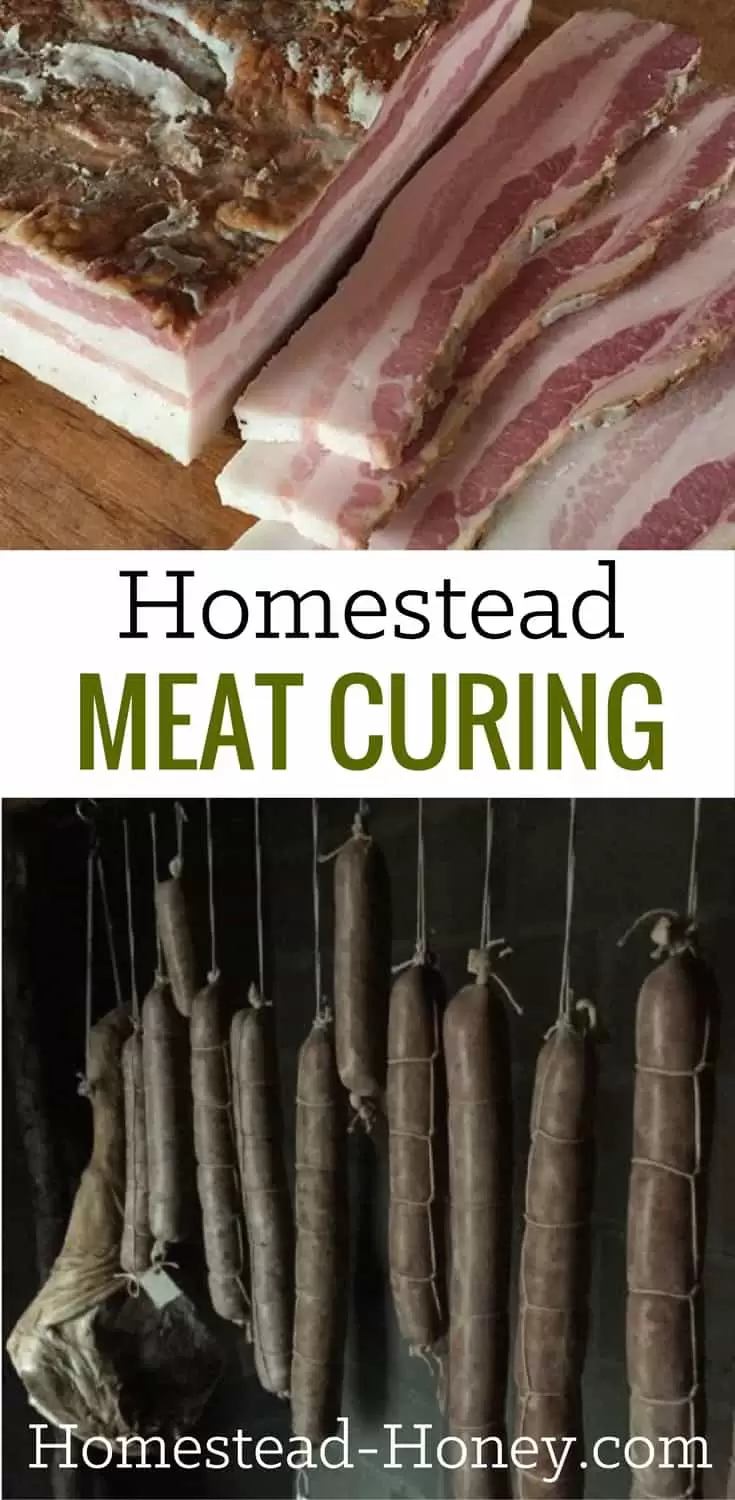

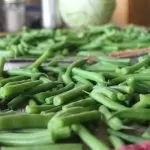

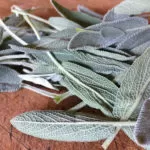




OOOOH it all looks so goooood! I can’t wait…charcuterie is on my to-do list for the 2017 season. 🙂 Cheers, and I bet it all turns out delicious!
We’ve been enjoying the salami, but the prosciutto is still a work in progress. It got too warm in our root cellar because we hadn’t yet covered it with soil, so we ended up re-salting the prosciutto and we’ll hang it for a few more months!
We just had two pigs butchered. Have you tried organic slats and or spices for curing? I am trying to find a way that is safe without the bad for you chemicals, any suggestions?
Yes, we definitely use organic spices, etc. for curing. The only thing that we sometimes debate about, bad for you wise, is the addition of pink salt. But in the end, we usually end up using it, because it’s such a small amount.
We just had two pigs butchered. Have you tried organic slats and or spices for curing? I am trying to find a way that is safe without the bad for you chemicals, any suggestions?
where did you find your recipe for curing with the organic spice
By ‘Pink Salt’ do you mean Himalayan pink salt? It isn’t bad for you….only “table” salt is bad for you…like MOrtons.
In meat curing, Pink Salt refers to a curing salt that is a mix of sodium nitrite and table salt. I believe they are colored pink artificially so people don’t confuse the curing salt with table salt.
N’duja is my all time favorite! I had it when I was in Calabria and have dreamt about it for 12 years since! 🙂
that’s so cool! I’ll have to take a closer look at the recipe and see if we can make some!
It would be nice to know what you did to the bacon, as I have that project on my list as well.
It is a pretty simple bacon recipe – just some salt and a bit of sweet. This is the site of the author who co-wrote Charcuterie and Salumi. You might find his step by step helpful: http://ruhlman.com/2010/10/home-cured-bacon-2/
I love learning about traditional methods of preserving and flavoring meats, but it also scares me a little. I don’t know if I have the courage. When you first started, did you have teachers/mentors?
I can’t speak for Teri, but when we first started out, we learned from books. If you’re looking for a community of meat curers, there are some facebook groups out there. Another good way to start is to cure something small (cure in a sheep casing or make a pepperoni–they cure faster and are less likely to “go wrong.”) Or cure something that you plan to cook anyway in case you’re queasy about the raw meat factor. It is so empowering to do something like this yourself. I hope you give it a try!!
No, no mentors with regards to meat curing! Just some good books and jumping in! But we did start with smaller cures, like Karen mentions.
Something about “bathroom” with “meat curing” just took the romance out of this story for me. Best luck.
Yeah, it wasn’t the most elegant solution. Good thing we’ve moved up in the world!
Awesome! How exciting. I can’t wait! Our ham and bacon and salami is still on the hoof. I’m so jealous!
It will just be a matter of time until you’re doing the same! We only butchered our pig in November. So worth the wait!
Welcome to the world of dry curing meat! I mean, well, not “welcome” since you were doing it before in the cupboard, but still. It’s exciting to have something to wait for and look forward to. If you don’t mind, for your readers who may be interested in dry curing/fermenting meat, may I humbly proffer this resource: http://www.swisshillsferments.com/meats.html
Thanks Karen. When I looked at your website, The Cave reminds me of a higher-tech version of our cupboard! This summer we actually cured a filetto under our bed! Thanks for sharing your resources!
I’m really excited to read the dry-curing article – I’ve been trying to find ways to make biltong (South African cold-dry-cured meat that far surpasses any jerky from the US), especially in the humid SE USA